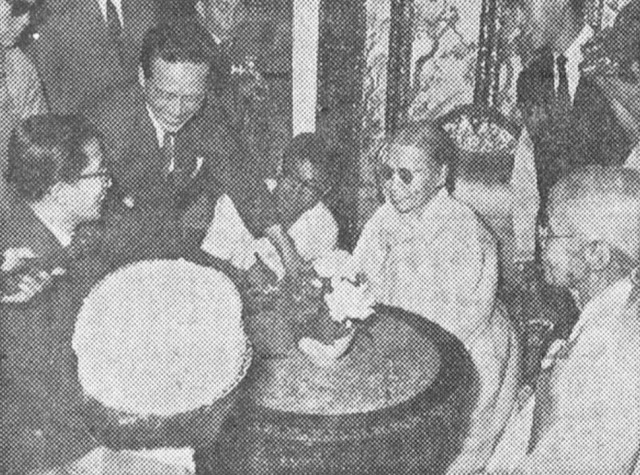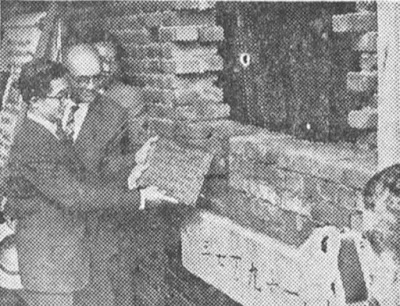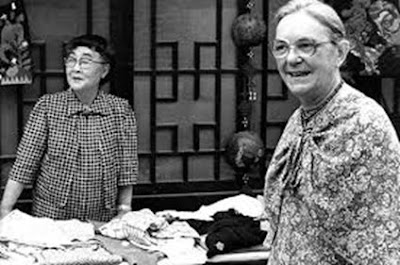Update:
A video of the July 13 RAS lecture by Seulkee Nahm and Dr. Cameron Pyke about Yi Bang-ja’s social welfare work in Korea can be seen here.
Original Post:
On May 12 I was shocked to find out that Peter Bartholomew had passed away suddenly. I'd known Peter for over a decade through the Royal Asiatic Society. He first came to Korea in 1968 as part of the Peace Corps’ K-5 group, and was sent out to Gangneung to teach English. As related in Andrew Salmon’s obituary,
Perched on a heavy delivery bicycle he took to touring the backroads during his time off. On one of these trips, he came across a compound of traditional buildings — and decided to enter.Inside, he chatted with an old woman who he assumed to be a groundkeeper or gardener. The two hit it off.When she heard of the rough digs Bartholomew was living in, she insisted he move into her compound. She turned out to be an aristocrat connected to the royal family and the owner of the palatial, three-century-old manse, Seongyojang.Bartholomew took up residence in a fairytale location: A traditional pavilion/home perched over a water-lily pond. For decades after, he would recall the magic of those days.
It was through this family that he met members of the royal family in Seoul and befriended a number of them. (He also told me an amusing story of how the women who owned the estate would go to Seoul every month and buy gold to hide under her floorboards, and she trusted him so much that before she died, she showed him the location of her gold stash, and told him not to reveal its location until her eldest son died, because she knew that he would waste it all. He kept his promise.)
During a phone conversation back in January, Peter and I discussed Korea's royal family, and he shared with me some files containing a wealth of information about them. This prompted me to do some digging and find articles about the return of the royal family from exile in 1962 and 1963. This became the basis of the Korea Times article I wrote that was published today.
To both recap and expand on what I wrote in the article, King, later Emperor, Gojong had four children who lived to adulthood: Sunjong, who was placed on the throne early, against Gojong’s will, in 1907, and who lived in Changdeok Palace. As Peter described it, after 1910 the royal family reigned as monarchs in name only and totally ceased to be rulers of Korea. Sunjong died in 1926, leaving his widow, Queen Yun, behind, and she moved into the Nakseonjae compound, where she lived in a new, modernized building, built in 1927, called Seohanggak. As this article from two years ago pointed out, it was she who hosted Royal Asiatic Society for tea there in 1959, starting the tradition of the RAS garden party. It also seems she was a rather tough woman; after her husband’s death,
Queen Yun continued to live in the palace, with her ladies-in-waiting, having had no children. Staying there during the 1950 invasion by the communists, it is said a military squad invaded the palace, but withdrew when the queen rebuked them. As Seoul became devastated by the war, she was forced to retreat to Busan. The stories say she went on foot.
Yi Gang, Gojong’s second son, did not become a Crown Prince due to his mother's status. He had no children with his wife but had 22 children with concubines. In 1917 his second son, Yi U, was posthumously adopted by his father’s cousin, Prince Yeongseon, and inherited Unhyeon Palace, which had been the Taewongun’s estate before (and after) his son Gojong was chosen to be king. Yi U was taken to Japan at the age of five to be educated and became an officer in the Japanese Army. He was killed by the atomic bomb in Hiroshima in 1945. His wife, Park Chan-ju, inherited Unhyeon Palace and continued to live there until 1993, when she sold the palace to the city of Seoul, which opened it to the public. (Because it had been privately owned by the Taewongun and passed down to his heirs, it was not considered Royal Property, and hence the national government did not take possession of it after liberation.) Another son of Yi Gang, Yi Su-gil, appears in photos below.
Gojong’s third son, Yi Eun, who became the Crown Prince, was taken to Japan as a child to be Japanized and married to a Japanese princess (Masako, or Bang-ja in Korean), and only returned on a handful of visits (he wasn’t allowed to go home for his mother’s funeral) before his final return to Korea as an invalid.
Equally sad was the story of Princess Deokhye, who was doted on by Gojong (she was only seven when he died) and taken to Japan in 1925 to be Japanized and married off to a Japanese prince. Unlike Yi Eun and Yi Bang-ja’s marriage, hers was an unhappy one, and she suffered from mental illness.
Peter sent me this photo, taken from this page, and described the “amusing vignette” found in the photo:
Notice that 12 or 13 year-old Princess Yi Tŏk Hye (in court dress) is at the top of this stairs and afraid to step down, as the mat “runner” (covering stairs and open area below) has slipped down stretching the mat out at an angle across the stair and no longer covering it in a flat, secure manner. A lady on her left is reaching out to steady her while waiting for someone on the left who appears to be stepping down to ‘straighten out’ the runner for the little Princess.
As conveyed in my article, the former royals lost their status after Japan's defeat in WWII, and Syngman Rhee refused to allow them to return to Korea. They became Japanese nationals, and Yi Eun and Yi Bang-ja (Masako)'s son, Yi Gu, studied in the US, became an architect, and married Julia Mullock, an American woman. Yi Eun suffered a stroke in 1961 that left him increasingly unaware of his surroundings. It wasn't until that year, when Park Chung-hee came to power in a coup, that they were invited to return home. Curious about their return to Korea, I looked through newspapers and found the following photos and information:
1962.01.26 Princess Deok-hye's arrival at Gimpo airport (from here, where more photos from her childhood can be seen):
Princess Deok-hye arrived at Nakseonjae and visited Queen Yun before being taken to SNU Hospital.
1962.01.30 Princess Deok-hye was visited by Yuk Yeong-su, Park Chung-hee’s wife, at SNU Hospital.
1962.02.08 Princess Deok-hye recovered her Korean nationality.
On February 8, the Ministry of Justice announced that Yi Deok-hye had recovered her Korean nationality. According to the (then) Nationality Law, Article 14, Paragraph 1, when someone who has lost Korean nationality has an address in Korea, they can restore their Korean Nationality with the permission of the Justice Minister.
A day earlier, the Donga Ilbo reported that On January 16, ahead of Deok-hye’s return, Park Chan-ju, owner of Unhyeon Palace and widow of Yi U, who was killed in Hiroshima, went to Japan and met with Yi Eun and received from him the documents that he wanted to submit to reclaim his Korean citizenship. She brought them back to Korea and on February 6 Unhyeon Palace manager Kim Taek-su submitted them to the Ministry of Justice on Yi Eun’s behalf.
1962.04.10 Princess Deok-hye began receiving a monthly stipend from Korean government.
On March 28, the Standing Committee of the Supreme Council for National Reconstruction decided to revise the Former Imperial Family Property Law so she could receive living expenses from the government.
On April 10, 1962, the Former Imperial Family Property Law was amended to include, in Article 4, paragraph 2, Yi Deokhye as a member of the Former Imperial Family who would have living expenses paid for, effective immediately.
The Former Imperial Family Property Law (구황실재산법) was first promulgated 1954.9.23 and revised 1961.10.17 when article 4 added these specific names to Article 4 – who would get the monthly expenses covered:
1. 낙선제 윤씨(純宗의 夫人) (순종의 부인) [Queen Yun]
2. 삼축당 김씨(高宗의 夫人) (고종의 부인) [Lady Kim, a concubine of Gojong's]
3. 광화당 리씨(高宗의 夫人) (고종의 부인) [Lady Ri, a concubine of Gojong's]
4. 사동궁 김씨(李堈의 夫人) (이강의 부인) [Lady Kim, widow of Yi Gang]
5. 리은과 그 배우자 [Yi Eun and spouse]
Number 5 makes clear that as early as October 1961, the way was paved legally for Yi Eun and Yi Bang-ja to have their expenses covered. This is interesting considering that they were not yet living in Korea nor were they citizens.
It was then revised 1962.4.10, as noted above, to include “6. 리덕혜(高宗의 女)” [Yi Deok-hye]. Then the 구황실재산법 was abolished on 1963.2.9, and it was replaced by the 구황실재산관리특별회계법 [Former Imperial Family Property Management Special Accounting Law] promulgated 1963. 2. 26.
Princess Masako (Yi Bang-ja)’s June 1962 visit to Korea
1962.3.21 It was announced that plans to bring Yi Eun to Korea were on hold since he was sick, so Yi Bang-ja planed to visit Korea in April to solve their nationality problem. An article about this speaks of the efforts General Park had made on their behalf. (The visit was postponed to mid-June, 1962.)
Here we see Nakseonjae in Changdeok Palace being prepared for her visit.
1962.06.14 Princess Masako arrived in Korea, was greeted by Yi Su-gil (son of Yi Gang), and was taken to Nakseonjae, where she was greeted by Palace staff. One assumes the reception took place in the modern Seohaenggak building. This was her first visit to Korea since 1943.
(From here.)
(These two photos were sent to me by Peter; I'm not sure of their source.) [Update: JiHoon Suk tells me "they are official photos published by the government and the originals are held at the National Archives."]
1962.06.15 Princess Masako met with Park Chung-hee at the capital building.
She noted the various kindnesses Park extended to her, though Park told her that her husband couldn’t be given citizenship until he landed on Korean soil. As soon as he was at the airport, however, he could receive it immediately, and the government would make it as convenient as possible.
She also visited the justice and foreign ministries, and stopped in at the Blue House to visit Yuk Yeong-su.
(The photo below was sent to me by Peter; I'm not sure of its source.)
During her time in Seoul she also visited the tombs of Kings Gojong and Sunjong and visited Jongmyo, as seen in the photo below:
On June 19 she left Korea and returned to Japan. According to her autobiography, a change in the law in the November allowed her to obtain citizenship for her husband without him being in the country; she visited briefly in December 1962 to pick up the documents.
1963.06.19 Prince Yi Gu Visited Korea for the first Time with his wife, Julia.
(Kyunghyang Shinmun, June 19, 1963)
(Donga Ilbo, June 19, 1963)
They were taken first to visit Queen Yun at Nakseondae. They also visited Yi Su-gil and Park Chan-ju.
(Korea Times, June 13, 1971)
(From here.)
(From here.)
1963.06.20 - They visited with Park Chung-hee at the Blue House, went to Gojong and Sunjong’s tombs, visited Chil-gung (shrine of the seven concubines).
They also visited Deok-hye at SNU hospital.
While in Seoul, they stayed at the Bando Hotel, where they received visitors, and visited Sukmyeong, Jinmyeong, and Yangjong high schools (first photo below), which were all established by his grandmother, Lady Om, ca. 1900, and visited the YMCA on Jongno (second photo below), and took a look at Walker Hill. They then flew to Japan June 23 after their five-day visit, but not before stating that Yi Eun’s health was improving and he might be able to visit soon.
(Both photos are from here.)
1963.11.22 Prince Yi Eun finally returned to Korea from Japan. He, Yi Bangja, Yi Gu, and Julia all flew to Seoul from Japan (after Emperor Hirohito held a dinner for Yi Eun's family). Yi Eun was taken in an ambulance directly to St. Mary’s Hospital.
(From the Korea Times)
Prince Yi Eun’s motorcade passing over the Han River Bridge:
Prince Yi Eun’s motorcade driving into St. Mary’s Hospital grounds cheered by students from Sukmyeong and Jinmyeong Girls’ High Schools (founded by his mother).
At St. Mary’s Hospital Yi Gu and Yi Bang-ja talked to the press. (Both photos from the Korea Times.)
1963.11.23 Prince Yi Gu, Princess Yi Bangja, and Yi Su-gil at Changdeok Palace (just west of the Nakseondae compound).
Yi Eun remained bedridden for the rest of his life.
Above is a photo of Julia Yi and Yi Bang-ja together. According to Peter, they had a professional relationship: Yi Bang-ja fashioned ceramics, pottery, and cloisonee and Julia designed and produced children’s clothing and accessories. They had a shop selling these together, and they donated 100% of their profits to charity. At first they were in the lobby of the Tokyu Hotel (beside Namdaemun) until Yi Bang-ja did not feel well enough to sit in a tiny corner of the hotel lobby in her cramped shop. After that, Julia continued on alone in the Hyatt Hotel basement shopping restaurant arcade. Several long-standing members of the RAS have told me they knew Julia - she was active in the RAS and often invited people over for dinner; one person referred to her "cantankerous eccentricity." She and Yi Gu never had children but adopted a Korean daughter.
Julia and Yi Gu separated in the mid-1970s and divorced in 1982. Princess Deok-hye and Yi Bang-ja died within nine days of each other in April 1989, Yi Gu died in 2005 in Tokyo, and Julia died in 2017 in Hawaii (she stayed in Korea until 1995).
A photo from the Korea Herald of Peter Bartholomew lighting incense at Yi Bang-ja's funeral.
Something Peter highlighted for me, as only he could with his knowledge of the Palaces' history, was the story of a building that is now gone. Yi Eun's family lived in Seohaenggak, which had been refurbished and prepared for Prince Yi Eun’s family.
Here is a good colour photo of Seohaenggak that Peter sent me (I'm not sure of the source) [Update: JiHoon Suk has let me know that it's his photo]:
Here is another colour photo of Seohaenggak that Peter sent me that shows the laneway approaching the north end of the building; this lane no longer exists (photo source unknown, taken in 1989 during the funeral of either Princess Deok-hye or Yi Bang-ja).
Here is a view of it sent to me by Peter that shows the Nakseondae building (built 1847) with the east wall of Seohaenggak visible on the left; the two buildings are connected by the passageway with the green metal roof.
Seohaenggak no longer exists; according to Peter, it was demolished in 1995. Compare this present Kakao map view of Nakseondae - a new wing now stands where Seohaenggak once did, and the greenery has been removed..
This photo shows, at top left, the pavilion that still stands behind the Nakseondae building today:
The pavilion can be seen here, and gives a sense of the empty space (and new wing of Nakseondae) that now exists where Seohaenggak once did.
Here's an altered Kakao map showing the approximate location of Seohaenggak (I'm not sure of its dimensions), as well as the dotted lines showing where the now absent lane once stood.
Certainly on past trips to Changdeok Palace no palace guides ever mentioned the fact that the last people to live in Nakseonjae were Japanese and American princesses, though considering a popular film was made about Deok-hye several years ago, it's possible interest in the returned royals increased somewhat (though I doubt it). Peter shook his head in disbelief at the fact that a tour guide he talked to had no idea Seohaenggak had ever existed ("then why is there a terraced garden next to an empty space?"), so I made sure to include it above.
It is to Peter that I dedicate this post - I likely wouldn't have gotten interested in the topic, and certainly would never have learned so much about it, if not for Peter telling his stories and sharing information with me. (To be honest, what is above just scratches the surface of the materials he shared.)
For more on Peter, see Robert Neff's obituary here.
Next Tuesday, July 13, the Royal Asiatic Society will host an online lecture by Seulkee Nahm and Dr. Cameron Pyke about Yi Bang-ja’s social welfare work in Korea. [Edit: A video of the lecture is here.]
As well, the RAS has copies of “The World is One: Princess Yi Pang Ja's Autobiography” available for sale.









































Very nice write up Matt. I learned a lot.
ReplyDeleteThe second photo of Seohaenggak, or Sinnakseonjae, is actually mine. The building was built in 1929 as an annex to the original Nakseonjae. Sadly, it did not survive the public wrath against "the Japanese legacy" in the 1990s. As for other photos from 1963, they are official photos published by the government and the originals are held at the National Archives. However, Peter did have prints of these in his hands that were probably given to him by Yi Gu.
ReplyDeleteThanks for the comment - I'll update the post.
ReplyDelete